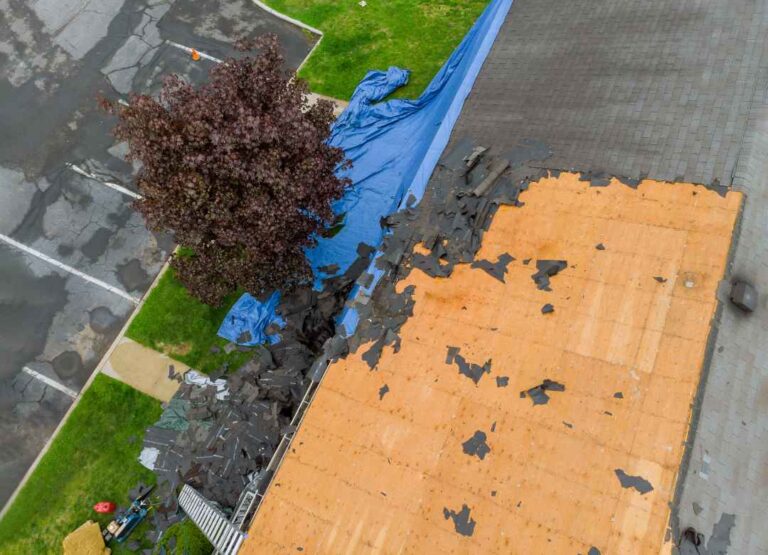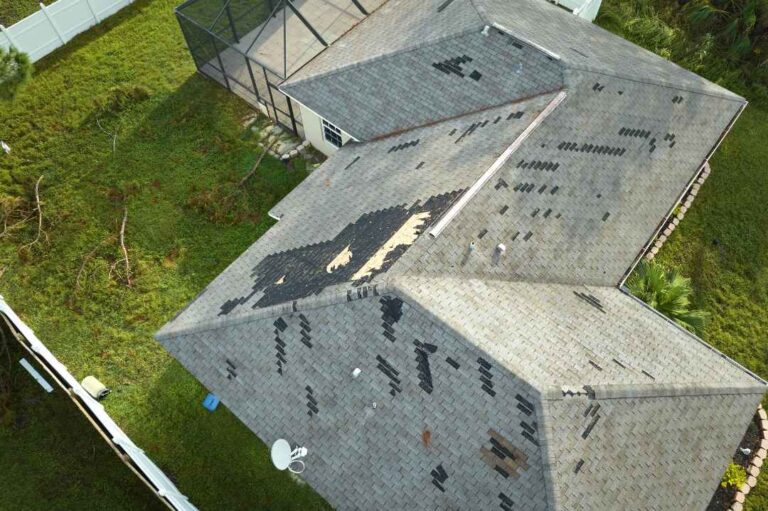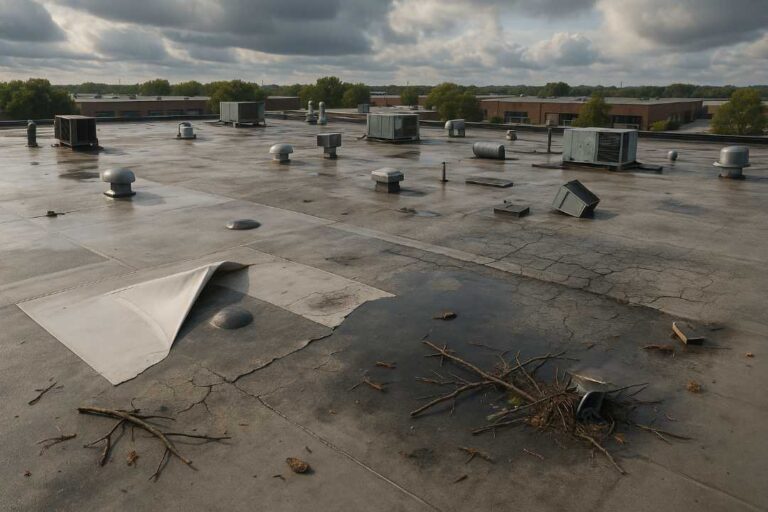The Silent Assault from Above – Understanding Hail Damage in Chicagoland
The roar of a thunderstorm is unmistakable, but often, the most damaging elements are deceptively quiet. While the thunder and lightning might grab your attention, it’s the hailstones – silent projectiles of ice – that can inflict significant, yet often unseen, damage to your home’s most vital protective layer: your roof. For homeowners across Chicago, from Naperville to Schaumburg, and from Plainfield to Buffalo Grove, hail damage is a frequent and destructive visitor, capable of compromising the integrity of various roofing materials.
After a hail storm, it’s natural to scan your property for obvious signs of damage, like broken windows or dented cars. However, roof damage, while often less immediately apparent, can be far more insidious. Unaddressed hail damage can lead to leaks, premature aging of your roof, and costly structural problems down the line.
At Seidel Exterior Group, we’ve been protecting and restoring Chicagoland homes since 1970. We understand the nuances of storm damage in our unique climate and specialize in identifying and repairing hail damage on all types of roofing materials. This comprehensive visual guide is designed to empower you, the Chicagoland homeowner, to better understand what hail damage looks like on the most common roof types: asphalt shingles, metal roofs, and cedar shake roofs. Knowing what to look for is the first critical step toward protecting your investment and ensuring your home remains safe and dry.
Why Identifying Hail Damage is Critical (Even if it Looks Minor)
Hail damage isn’t always immediately obvious, but its long-term consequences can be severe and expensive if left unaddressed. Here’s why a proactive inspection is crucial:
- Compromised Water Resistance: The primary function of your roof is to shed water. Hail impacts can create breaches, cracks, or weaken protective layers, making your roof vulnerable to leaks, especially during subsequent rain or melting snow.
- Accelerated Aging and Deterioration: Even if a hail impact doesn’t cause an immediate leak, it can significantly shorten your roof’s lifespan by damaging its protective layers (e.g., removing granules from asphalt shingles, weakening the integrity of cedar shakes). This can lead to premature roof replacement.
- Voided Warranties: Many roofing manufacturers’ warranties can be voided if hail damage is not addressed in a timely manner.
- Hidden Damage: Hail often causes damage that is not visible from the ground but can be found by a trained professional. This “hidden” damage can still lead to leaks and structural issues.
- Insurance Claims: Prompt identification and documentation of hail damage are essential for a successful insurance claim. Delays can complicate the process or even lead to denial.
- Energy Inefficiency: Damaged roofing can compromise your attic’s insulation and ventilation, leading to higher energy bills.
Understanding these risks underscores the importance of a professional hail damage assessment, even if you don’t see immediate signs of trouble.
The Ultimate Visual Guide: What Hail Damage Looks Like on Different Roof Types
Hail comes in various sizes, from pea-sized to golf ball-sized or larger, and its impact varies significantly depending on the roofing material. Here’s what to look for on common Chicagoland roofs:
1. Asphalt Shingle Roofs
Asphalt shingles are the most common roofing material in Chicagoland, and they are susceptible to hail damage in specific ways.
- What to Look For (Key Indicators):
- Granule Loss (Bruising): This is the most common sign. Hail impacts dislodge the protective, gritty granules from the shingle surface, exposing the darker asphalt or fiberglass mat underneath. These spots often look like dark, circular “bruises” or “pockmarks.” They might appear duller than the surrounding shingle.
- Asphalt Mat Exposure: When granules are lost, the underlying asphalt mat is exposed to UV rays, accelerating its deterioration.
- Fiberglass Mat Exposure: In severe cases, hail can impact with enough force to break through the asphalt layer, exposing the underlying fiberglass mat. This looks like small, black indentations with visible fibers.
- Circular Cracks: You might see small, localized cracks that radiate outwards from the center of an impact point, often circular or star-shaped. These cracks compromise the shingle’s water-shedding ability.
- Soft Spots/Spongy Feel (during inspection): A trained professional might feel “soft” spots on the shingle, indicating the asphalt mat has been bruised or fractured underneath, even if the granules aren’t completely gone.
- “Spiderweb” Cracks: On older or less pliable shingles, hail can cause a network of small, interconnected cracks.
- Collateral Damage to Look For:
- Dented Gutters and Downspouts: Often, the easiest indicator of hail, as metal dents easily.
- Dents on Metal Vents, Exhaust Caps, and Skylight Flashing: Look for circular dents on any metal components on your roof.
- Damage to Siding: Dents or chips on vinyl siding, or cracks on fiber cement siding.
- Deck or Patio Furniture Damage: If your outdoor items are dented or damaged, it’s a strong indicator hail was large enough to damage your roof.
- Cracked or Broken Windows (rare, but severe hail): An obvious sign of significant hail.
2. Metal Roofs (Standing Seam, Corrugated, Metal Shingles)
Metal roofs are renowned for their durability, but they are not immune to hail. Instead of granule loss, you’ll see physical deformation.
- What to Look For (Key Indicators):
- Dents and Dings: The most common sign. Hail impacts create circular or irregularly shaped indentations on the metal panels. These might be subtle or quite pronounced, depending on hail size and metal gauge.
- Scuff Marks/Discoloration: The hailstone can leave scuff marks or minor paint abrasion at the impact point, especially if the metal has a coating.
- Pitting: In some cases, sharp or large hailstones can create small, deeper pits in the metal.
- Compromised Coatings: While metal roofs are tough, severe hail can compromise protective coatings, potentially leading to rust over time if left unaddressed.
- Important Note: The functionality of a metal roof can be compromised even if the damage seems purely cosmetic. Dents can create tiny channels that trap water, potentially leading to rust or even subtle leaks over many years. Also, cosmetic damage can significantly reduce your home’s curb appeal and resale value.
- Collateral Damage to Look For:
- Dented Gutters and Downspouts: Very prominent on metal, confirming hail activity.
- Damage to Chimney Caps, HVAC Units, and other rooftop equipment: Look for dents or punctures.
3. Cedar Shake Roofs
Cedar shake roofs offer a unique aesthetic but react differently to hail compared to asphalt or metal.
- What to Look For (Key Indicators):
- Splits and Cracks: Hail impacts can cause individual cedar shakes to split, crack, or even splinter. These cracks often run perpendicular to the wood grain.
- Gouges and Impact Marks: Deeper, localized indentations or gouges where the hailstone has removed pieces of wood.
- “Soft” Spots/Wood Fiber Damage: Similar to asphalt, a direct hit might soften or compromise the wood fibers, even if a visible crack isn’t immediately apparent. This weakens the shake’s integrity.
- Widespread Damage: Cedar shake roofs often show a more random pattern of damage across the roof, rather than uniform impacts, depending on the angle of hail.
- Important Note: Cedar shakes naturally weather and can develop minor surface imperfections over time. Distinguishing between normal wear and tear and actual hail damage requires an experienced eye. Fresh, sharp splits or gouges are usually indicative of recent hail.
- Collateral Damage to Look For:
- Damage to Wooden Decks, Fences, or Patio Furniture: Look for similar splits or gouges in other outdoor wood structures.
- Siding Damage: Especially if your home has wood siding.
What to Do if You Suspect Hail Damage
Spotting potential hail damage from the ground is a great first step, but a definitive diagnosis requires professional expertise.
- Prioritize Safety: Never climb on a roof yourself, especially after a storm. It can be slippery, unstable, and dangerous.
- Document What You See: Take photos and videos of any suspicious areas you can safely capture from the ground. Note the date of the storm.
- Check for Collateral Damage: Look for dents on cars, outdoor furniture, siding, and window screens – these are strong indicators that your roof likely has damage too.
- Call Seidel Exterior Group for a FREE, Professional Inspection: This is the most crucial step. Our experienced storm damage assessors are trained to:
- Identify all types of hail damage, even subtle impacts.
- Distinguish between hail damage and normal wear and tear.
- Assess the full scope of the damage to your entire exterior (roof, siding, gutters).
- Provide thorough documentation and an accurate estimate for repairs.
- Advise you on whether to file an insurance claim and guide you through the process.
- Contact Your Insurance Company (After Seidel’s Inspection): Once you have our professional assessment and documentation, you’ll be well-prepared to open a claim with your insurance provider. We can even meet with your insurance adjuster on-site to ensure all damage is properly identified and accounted for.
Why Choose Seidel Exterior Group for Hail Damage Repair in Chicagoland?
When it comes to hail damage, you need a local, experienced, and trustworthy partner. Seidel Exterior Group is that partner for Chicagoland homeowners.
- Local Expertise: We’ve been operating in Illinois since 1970, giving us unparalleled understanding of local weather patterns, building codes, and insurance practices.
- Comprehensive Services: We don’t just do roofs. We specialize in roofing, siding, gutters, and windows, ensuring a holistic approach to your home’s exterior restoration.
- Insurance Claim Specialists: We have extensive experience working with all major insurance companies. We can streamline your claim, ensuring you receive a fair settlement for all necessary repairs.
- Quality Workmanship: Our certified crews use only the highest quality materials and adhere to rigorous installation standards, ensuring your roof is restored to be more resilient than ever.
- Free Inspections: We offer no-obligation, thorough inspections to give you peace of mind and an accurate assessment of your hail damage.
Don’t Let Hidden Hail Damage Threaten Your Home
Hail damage is a stealthy threat that can silently compromise your roof’s integrity, leading to costly problems down the road. Understanding what to look for on your asphalt, metal, or cedar shake roof is the first step, but a professional assessment is truly indispensable.
Don’t wait for a leak to discover hail damage. If your Chicagoland home has been in the path of a recent hail storm, act proactively. Contact Seidel Exterior Group today for your free, comprehensive hail damage inspection. Let us help you protect your investment, navigate the insurance process, and restore the safety and beauty of your home’s exterior. Your peace of mind is our priority.



